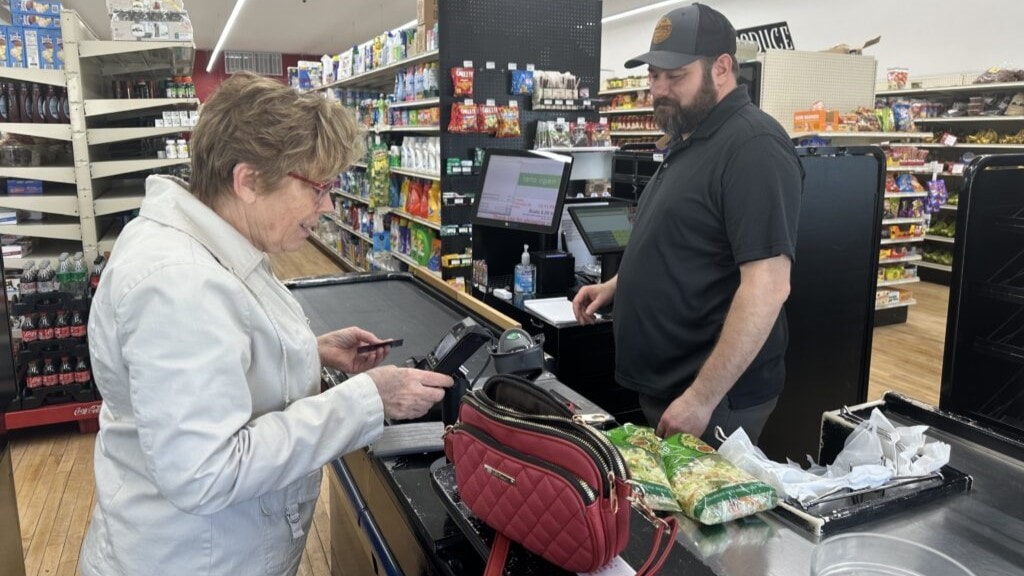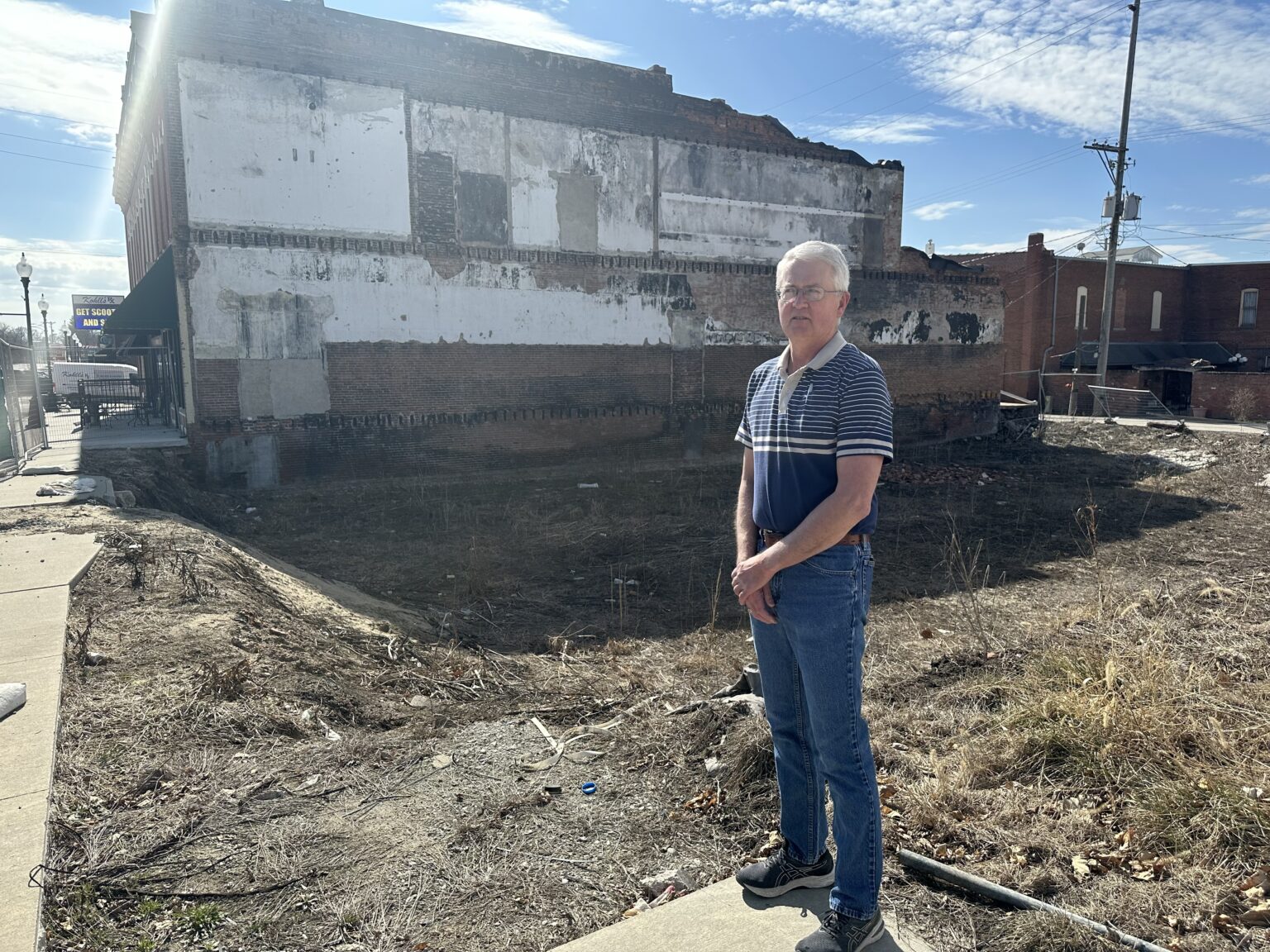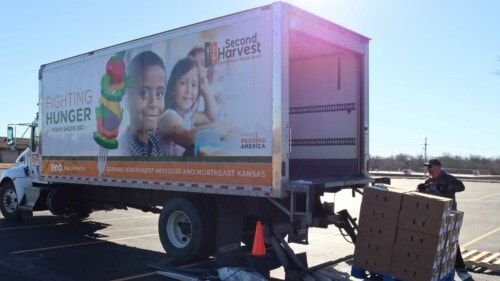‘Lifeblood of the Community’: States Invest to Save Rural Grocery Stores Lawmakers hope grant and loan programs can help small towns keep their markets open.
Published March 8th, 2024 at 9:13 AM
Above image credit: General Manager Brian Horak walks down an aisle at Post 60 Market in Emerson, Neb. Locals opened the market as a cooperative in 2022 after the tiny town lost its only grocery store. Lawmakers in Nebraska and other states are seeking to provide loans and grants to keep small rural markets open. (Kevin Hardy | Stateline)EMERSON, Neb. — Corliss Hassler rushes in the front door of Post 60 Market and heads straight for the produce case of the grocery store.
“I’m back,” she announces.
It’s around lunchtime, but it’s already her second trip in today — this time, she’s picking up a few items for the Friday fish fry at the local Catholic church.
Hassler is a regular customer and investor in the small grocery store, opened in 2022 as a cooperative. The store provides convenience, sure. It’s the only place in town to buy fresh fruits, vegetables and meats. But it’s also a social hub for the northeast Nebraska town of Emerson, population 891.
“The store is the lifeblood of the community,” Hassler said. “We have to keep our store, we have to keep our schools, we have to keep our churches — and it’s all a struggle right now.”
The market opened four years after the closure of the town’s only grocery store. Some 110 community members bought shares, which funded the transformation of a shuttered American Legion post into a brightly lit store packed with fresh and packaged foods.
Preserving grocery stores has been a perennial challenge for rural communities. Small, often declining populations make it tough to turn a profit in an industry known for its razor-thin margins. Increased competition from online retailers, the onslaught of chains such as Dollar General stores and an aging lineup of independent grocers have only made things tougher.
The U.S. Department of Agriculture has tracked the decline of rural grocery stores.
By 2015, USDA research showed a total of 44 counties had no grocery store at all — all but four of the counties were rural.
In Kansas, 1 in 5 rural stores closed between 2008 and 2018, according to the Rural Grocery Initiative at Kansas State University. No new store has opened in half of the 105 communities that lost grocers over that time.
It’s a place where you see your neighbors, where your teenagers get their first job, where there’s a bulletin board with help wanted and things for sale. So it’s a really important part of the social infrastructure in our small rural towns.
– Jillian Linster, Center for Rural Affairs
Proposed legislation at Nebraska’s capitol in Lincoln could provide some relief for stores like Post 60 Market.
If passed, the new law would provide grants and loans for small grocers. It’s among several legislative efforts in the region that aim to tackle the complex problem. In neighboring Kansas and Iowa, lawmakers have introduced bills with similar goals, following the lead of states — including Illinois, Minnesota, North Dakota and Oklahoma — that have enacted laws setting up special funds to boost rural grocery stores.
“We’re in a global economy and Amazon’s dominating, but that doesn’t mean we should surrender,” said Kansas state Sen. Rob Olson, a Republican.
For two years in a row, Olson has introduced bills that would provide tax incentives for the development of rural grocery stores. A native of rural Kansas who now represents a suburban Kansas City district, Olson said lawmakers should be investing in grocery stores, broadband and housing to improve rural communities.
“If we think about it and we’re smart about it, there’s plenty of opportunities — all throughout the Midwest especially — to grow these economies,” he said.
The pandemic underscored both the importance and fragility of rural grocery stores, said Jillian Linster, interim policy director at the nonprofit Center for Rural Affairs.
“After the pandemic, we have seen a lot of these local grocery stores just struggling to keep the doors open with all the economic and workforce challenges we face in the current economy and the competition from the big-box retailers,” she said.
Based in Lyons, Nebraska, the center has backed bills in both Nebraska and Iowa this session to provide small grants or loans to grocery stores with fewer than 25 employees in underserved communities. The hope is that providing money to replace a broken freezer or leaky roof could make the difference in keeping stores open.
Aside from preserving fresh food access, Linster said, grocery stores serve a wider social role.
“It’s a place where you see your neighbors, where your teenagers get their first job, where there’s a bulletin board with help wanted and things for sale,” she said. “So it’s a really important part of the social infrastructure in our small rural towns.”
‘Service to the Community’
Brian Horak knows his customers.
The general manager of Post 60 Market, he knows the busy mom who runs to the frozen foods aisle to find something for dinner that night. He knows the families that only load up their carts on paydays. And he knows when he should check up on someone who hasn’t been in for an unusually long stretch.
Emerson sits at the convergence of three counties, including one of Nebraska’s poorest.
The market can’t compete with the prices of mega retailers like Walmart. But Horak tries to at least beat the costs found at the regional grocery store chain 20 miles away and loads the shelves with plenty of generic options.
Still, some customers will pay with loose change. Others drop in to rummage through the bin of discounted items nearing their expiration dates.

Remote stores like this can struggle to secure vendors. No bakers will deliver fresh bread here, so all the sandwich bread, buns and cupcakes come in frozen. And the store only gets one delivery of fresh food every Wednesday.
“By Tuesday, the bananas start to look pretty sketchy,” Horak said.
But whatever it lacks in variety, the store makes up for in service. Horak will special order just about anything if customers ask.
On a back shelf, he’s set aside a case of Rice-A-Roni for one man, a pack of small Pepsi bottles for a woman in a nursing home and a case of wet cat food for a woman who feeds strays. One man has a standing order for a case of pickled beets every week.
There have been some months when Horak wasn’t sure Post 60 Market’s doors would remain open.
But things changed for the better in January, when a storm blanketed the region with record snow. The two-lane roads connecting Emerson to Sioux City were impassable for days, pushing many locals to try or rediscover Post 60 Market.
“It was kind of a wake-up call,” he said. “People were so happy the grocery store was here.”
The pending legislation could help with a litany of items on the market’s to-do list: a leaky basement, the rubber gaskets that need replacing on the produce cooler — not to mention the dream of a room to butcher fresh cuts of meat.
Nathan Mueller, who leads the co-op board, said the store just aims to break even.
“At its heart, this is a business,” he said. “But really, the business is being a service to the community.”
Nebraska state Sen. Teresa Ibach said rural grocery stores, whether they’re for-profit, cooperatives or nonprofits, deserve the state’s support.
“I think the trade-off is, if you’re willing to invest in small local communities, we are willing to invest in you.”
A Republican, Ibach sponsored the legislation that would set aside $4 million over two fiscal years for rural grocers. While the legislation got favorable reviews during its January hearing, Ibach was unsure whether it would advance out of committee.
“It’s got legs and it’s got substance and I hope it does, but we’re halfway through the session already,” she said. “And so who knows what will make it to the floor.”
If approved, the measure could help Greg’s Market in Exeter, Nebraska, about 50 miles west of Lincoln. The store has “a honey-do list a mile long,” said Mitchell Schlegelmilch, who leads the board overseeing its operation.
Just before he heard about the legislation, Schlegelmilch said, a freezer sensor failed, costing some $2,500 in spoiled inventory.
“It was a real punch in the gut,” he told lawmakers at the January hearing. “It just took our breath away.”
Investors aren’t looking to make money or even get their money back, Schlegelmilch said in an interview. Greg’s Market just aims to break even. So something as seemingly small as the failed sensor could pose an existential threat.
The legislation “gave me a sense of relief that maybe there is hope,” he said.
Investing in Grocery Stores
Kathryn Draeger says rural communities need more than just dollar stores and gas stations.
“We need places where you can buy a kiwi, an onion, potato, beets,” she said.
The director of regional sustainable development partnerships at the University of Minnesota, Draeger works with grocery stores across the state. Aside from the health benefits of fresh food, she said, rural stores are key to building more resilient supply chains since they can procure products from a variety of small vendors.
Draeger advocated for a state program to improve healthy food access that began offering grants to rural and urban stores in 2017. Last year, the state agriculture department funded 15 projects at a cost of $426,862 — though nearly five times as much was requested.
“I believe every rural grocery store we lose is at our own peril,” Draeger said. “There’s so much public good in these small private businesses. That is why this public investment in this private sector is really important. “
Draeger recalled one Minnesota grocer who had to choose between fixing her broken front tooth or her store’s leaky roof.
“She chose the roof,” Draeger said. “So she worked at the cash register at the store she owned without a tooth for over a year.”
Just as important as money, though, is leadership, said North Dakota Democratic state Sen. Kathy Hogan. She co-sponsored a new law last year that made $1 million available to help preserve rural grocery stores. That money will only help if communities have strong leaders willing to work together, she said.
“Sometimes people think money is the answer to everything,” she said. “The secret of the success of this is not so much money but local organization.”
Republican state Sen. Janne Myrdal, another co-sponsor, said the legislation was inspired by the work of grocery stores, communities and schools in the northeast corner of the state. After struggling to find vendors willing to make small deliveries to remote areas, three stores formed a cooperative that can demand more inventory and better prices from suppliers — benefiting consumers, schools and businesses.
“As a conservative, I love seeing that happen,” Myrdal said.
The legislation required a local match from organizers and aims to pull multiple retailers and community organizations together to help stabilize deliveries and costs.
“I don’t believe in just handing out money from the government,” Myrdal said. “It has to rise from the bottom up.”
Town Missing its ‘Centerpiece’
People like to say the town of Malvern, Iowa, punches above its weight.
Though it’s home to fewer than 1,300 people, the town touts miles of bicycle trails, a community garden and public art sculptures. On Main Street: two restaurants, medical clinics, a bank, a pharmacy and even a fitness center.
But a fenced-in gaping hole is an obvious reminder of what’s missing: the town’s staple grocery store, lost in a 2021 fire.

Tom Mulholland was the fourth-generation owner of Mulholland Grocery, which traces its history to the 1870s.
Since the fire, the community has rallied around him. Meta, parent company of Facebook and Instagram, funded a documentary short film about the effort to rebuild the grocery store last year.
But even with an Oscar-winning documentarian as the director and scores of headlines, Mulholland has struggled. He’s faced problems with insurance, finances and construction headaches that set the rebuild back.
My great-grandfather and my grandfather, everybody put in so many decades of sweat and tears and frustration and joy. And on my watch, it disappeared.
– Tom Mulholland, whose family market burned down in 2021
When the store was open, it was a hub of activity. People would drive long distances to buy from his meat counter. And in times of crisis, such as a recent flood in the area, customers would hand him cash, knowing he’d get it to the folks who needed it most.
“It’s those little things about being human and caring about your community and others that add up,” he said.
Mulholland, 63, could have walked away from the store. But he said it’s too important to the community — and his family. The morning after the fire, he wrote an apology to his ancestors on Facebook.
In an interview, he said: “My great-grandfather and my grandfather, everybody put in so many decades of sweat and tears and frustration and joy. And on my watch, it disappeared.” The fourth generation of his family to own the store, Mulholland aims to revive the operation that got its start as a dry goods store in the 1870s. Courtesy of Tom Mulholland
After two years, people around town have grown weary of waiting for a store.
“In here it’s a big topic of conversation,” said Janella May, who owns C&M’s Cafe with her husband.
It’s a Main Street institution known for its ice cream and Cheeseburger Saturdays — $4.99 for a burger and fries. Weekday mornings, the place is home to a coffee klatch — a few older men around town have their own key to get in before the place opens.
“We need it here,” she said of the grocery store. “It’s important.”
Without Mulholland Grocery, Malvern residents must drive 15 minutes to reach another small-town grocery store or a half-hour to reach supermarket chains over near Omaha.
The absence of the grocery store is a sharp contrast to Malvern’s otherwise encouraging trajectory.
Some $40 million worth of new projects are in the works in the town, including public school renovations, a new subdivision and a new early education center.
“We’re a growing town,” said Jay Burdic, the president of Malvern Bank.
The third generation of his family to own the bank, Burdic is bullish on the community’s future.
But every day brings a reminder of what’s missing: His desk overlooks Main Street, directly across from the empty grocery store lot.
“It was the centerpiece of our Main Street,” he said. “And now it’s just a hole in the ground.”
Kevin Hardy covers business, labor and rural issues in the Midwest for Stateline, where this story first appeared. Stateline is part of States Newsroom, a nonprofit news network supported by grants and a coalition of donors as a 501c(3) public charity.



